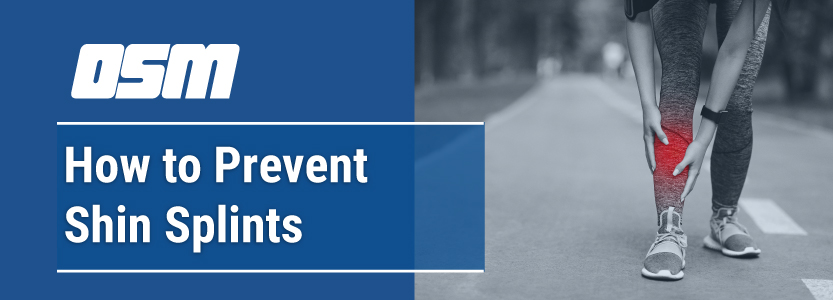How to Prevent Shin Splints
Article featured on Humpal Physical Therapy & Sports Medicine Centers
A shin splint, which is medically referred to as tibial stress syndrome, is a painful injury to the shin that commonly affects runners, but also dancers and other athletes.
Shin pain most often occurs on the medial side of the shin (termed medial tibial stress syndrome, or MTSS) but can also occur on the lateral or anterior side of the lower leg. Shin splint pain develops due to the overexertion of pressure on muscles in the lower legs causing stress on the tissues in that region. If left untreated, shin splints can lead to lower leg compartment syndrome or even a stress fracture.
Several risk factors have been identified to increase the likelihood of developing shin splints, particularly in runners. These factors include:
- being of female gender
- previously experiencing shin pain, having fewer years of running experience
- previously using orthotics
- having high body mass index
- having a dropped foot bone (the navicular bone)
- in males, the likelihood increases if you have excessive external rotation in your hips
Obviously some of these risk factors cannot be changed (such as your gender!) but many of these factors as well as others can be addressed by your Physical Therapist in order to lower your chances of developing shin splints.
Unfortunately there are no proven methods available to definitively prevent shin splints. There are several strategies, however, that may help in preventing shin splints. These strategies include wearing appropriate fitness shoes, warming up before engaging in recreational activities, gradually increasing activity so the body can adapt, discontinuing the activity if you start experiencing pain in the shins, keeping your body weight in check, and seeking the attention of a Physical Therapist before pain arises in order to assess your running or sport biomechanics.
For active individuals such as runners, it is important to take time to find a comfortable shoe that protects the foot and promotes normal mobility. Bulky and ‘shock-absorbing’ shoes may not be the ideal type to allow body’s natural foot and ankle placement. If you do not have any foot injuries or complications, minimalist type shoes, which replicate the movement of a bare foot are highly recommended. However, you will likely need to seek advice on transitioning from your current footwear to minimalist shoes to avoid injuries from sudden change.
Minimalist type shoes improve the strength of the feet over time by allowing the feet to bear more of the impact force that is experienced during physical activity. In addition, they promote an increased cadence (step frequency), which subsequently decreases the strain on your lower extremities. There is also reliable evidence available on prevention of shin splints by using shock-absorbing insoles within your shoes, however, more quality research is certainly required before this advice becomes universal. You can assess your running and walking pattern, as well as assess your foot and lower extremity alignment and biomechanics to help you determine the best footwear. Taking adequate time for the feet to adjust to new shoes and gradually increasing the level of physical activity, along with replacing your shoes regularly in order to maximize their function will also help to prevent injury.
Taking ample time to properly warm up before engaging in physical activity can also reduce the occurrence of injuries. A warm up that includes a short activity to get the heart rate up followed by dynamic stretching is best. Dynamic stretches are stretches that involve quick movements of the limbs and body and, for best results, should simulate the activity you are about to engage in. When athletes perform dynamic warm-ups, they typically demonstrate enhanced flexibility and improved performance. Runners, for example, may do dynamic stretching by swinging their legs back and forth to simulate running or do several jumps on the spot. These quick stretches stimulate the nervous system and increase the range of motion in the muscles and joints.
If you start experiencing pain in your shins during physical activity it is important to discontinue the activity and allow the muscles in the legs adequate time to rest and recover. Simple icing can be very effective in this early stage of pain. Continuing to exercise when pain is felt in the shins can cause overexertion, which may lead to chronic shin splints, or a compartment syndrome or stress fracture developing.
The Orthopedic & Sports Medicine Center of Oregon is an award-winning, board-certified orthopedic group located in downtown Portland Oregon. We utilize both surgical and nonsurgical means to treat musculoskeletal trauma, spine diseases, sports injuries, degenerative diseases, infections, tumors and congenital disorders.
Our mission is to return our patients back to pain-free mobility and full strength as quickly and painlessly as possible using both surgical and non-surgical orthopedic procedures.
Our expert physicians provide leading-edge, comprehensive care in the diagnosis and treatment of orthopedic conditions, including total joint replacement and sports medicine. We apply the latest state-of-the-art techniques in order to return our patients to their active lifestyle.
If you’re looking for compassionate, expert orthopedic surgeons in Portland Oregon, contact OSM today.
Phone:
503-224-8399
Address
17355 Lower Boones Ferry Rd Suite 100A
Lake Oswego, OR 97035
Hours
Monday–Friday
8:00am – 4:30pm



